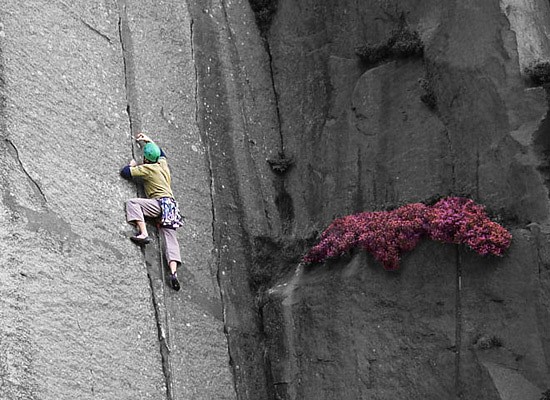
At the time, I was happy leading HVS, but had barely led anything harder since I started climbing over 10 years ago. E-anything was a major undertaking, and E4 might as well have been the moon. I considered myself to be a classic punter, yet after focussing on climbing and putting in some hard work, I managed to reach my goal! So this article is aimed at the hundreds of climbers out there who are leading around the VS/HVS mark, but wistfully looking across the crag at that classic E-something and thinking "I wish I was good enough to do that". Well, you can be good enough, as long as you're prepared to put in some hard work, and be patient.
Of course E4 isn't that hard anymore. The hardest sport route is graded at 9b, and if you call E4 sport 7a, then that's 14 grades difference! But let's think about what we consider 'difficult'. Of course 9b, E10 or V16 are the grades that represent the highest absolute difficulty, but I think one of the hardest challenges in the average trad climber's career is to break the HVS barrier and get comfortable leading in the E-grades, and that's the hurdle that I set out to conquer last year - with E4 being the ultimate goal.
So why would you want to lead E4? What wrong with staying at VS? After all, many of us have had some magical days climbing nothing harder than a V.Diff. What's the point in climbing harder? Well, it lets you climb on lots of crags that you otherwise might never go to – classic climbing venues such as Gogarth and High Tor aren't really worth visiting unless you're 100% comfortable at HVS, and to get the most out of them you need be happy leading E-numbers. Also, there's always the satisfaction of burning off your mates! For me, though, the most important factor in trying to climb harder is to set a distant goal, to work hard, and then reach it. Whether your goal is to get established at E1, tick an E4, or to onsight Right Wall at Dinas Cromlech, it doesn't matter – the satisfaction of reaching that goal, having worked hard towards it, is something that cannot be emulated.
So. 'How to Climb Harder' in ten easy steps? Not quite. However, by following these pointers below, you'll be able to push your grade without becoming a slave to the fingerboard...
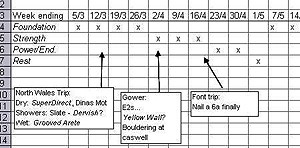
2. Gather information. Hearsay, forum-speak and internet sites are all easy ways to get information on training, but relying on them invariably leads to conflicting advice and plain confusion. A good training book costs less than a tenner, and will not only focus your efforts but will help inspire you to keep at it, as long as you can put up with reading the odd bit of US-style 'inspirational' guff. The ubiquitous Training for Climbing by Eric J. Hörst was my choice, though there are many others.
3. Make a plan. This is absolutely essential. With your newly acquired knowledge you can create some sort of training plan that fits in with both your day-to-day life and climbing goals. The most important point is that you have to make the effort to stick to it, without being too religious. This means maybe swapping 'playing bouldering games' for 'doing some proper training'; but not being so anal that you turn down a weekend's multi-pitching in the hills with your mates because "I'm supposed to be improving my plyometric grip strength this week".
4. Finger strength is the key. In the film Hard Grit, Ben Moon famously states, "for me to do the next hard problem, it really comes down to strength". He has a good point - while excellent technique is very important, as the grades increase the importance of a strong grip begins to dominate. Also don't forget that increasing your absolute finger strength also improves your stamina - by improving your finger strength you need to grip less hard on easier moves lower down on a route, leaving you with more energy for the crux higher up.

5. Understand specificity and variation. A fundamental concept of training for any sport is specificity – focussing closely on a particular weakness to improve it. An equally important concept is variation, periodically changing the focus of the specificity to avoid reaching a plateau. So, rather than going down the wall and doing every single exercise you can think of – group your sessions to focus on certain aspects for defined periods of time. As an example, a simple training plan overview might be, "Two weeks general easy climbing, two weeks finger strength training only, two weeks hard leading only, one week rest".
6. Go bouldering. 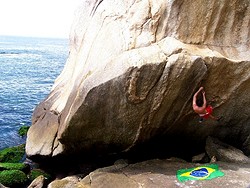
7. Go sport climbing. Another bitter pill for the traditionalists perhaps, yet there's no doubt in my mind that pushing your sport climbing grade can benefit your trad grade. It allows you to do hard moves, on real rock, at the sharp end of a rope. The only difference is the relative safety of a fat bolt to save you if it all goes wrong.
8. Fall off. The old adage of 'the leader never falls' holds no weight here. If you want to push your grade, then you are going to have to accept that there is a chance that you will fall off. Once you've accepted that, you need to conquer your fear of it. This becomes a positive feedback loop – if you're not scared you can concentrate more on the actual business of holding on to the rock, which makes you less likely to fall, which makes you less scared, and so on.
9. You are what you eat. Needless to say, a power to weight ratio is a good thing in climbing and so you should try to keep slim. Equally as important, though perhaps less obvious, is the role of diet in recovery. A good meal, consisting of lots of protein and carbs, within 2 hours of any hard climbing ensures plenty of fuel to enable your body to rebuild torn and tired muscles.
10. Be Patient. The last and most important point. Rome wasn't built in a day, and E4s don't climb themselves. If you see no increase in your grade within a couple of months of dedicated training, don't get frustrated and give up; try to identify why you're not improving, and how you can adjust your plan to target those weak points. Furthermore, sometimes you'll notice big jumps in your grade – nothing will happen for ages and suddenly it all comes together. Keep at it!
So does it all work? Here are the highlights of my grade progression from September 2004 to September 2005...
E1 – Like many HVS leaders, I had dabbled with some soft touch E1s in the past (rather pleasingly, the new Gower guidebook upgrades my first ever HVS, climbed as a 15 year old, to E1!) but would never have deigned to call myself, 'an E1 leader'. Two routes changed all this though – Debauchery on High Tor in the Peak District, and Superdirect, on the nose of Dinas Mot in North Wales. Doing them both on consecutive weekends really made me feel as if I'd 'cracked' E1.
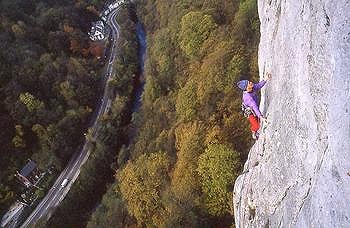
E2 – E2 was the next step and an early spring visit to my home-turf (Gower) ended up being a real turning point, not just because I climbed E2, but because I fell-off an E2! Halfway along the lip of Nick'd, a route that traverses along the lip of the huge, square-cut Giant's Cave, my foot popped off a sloping hold, and before I knew it I was hanging free in my harness, 10 feet from the lip (the nearest bit of rock!), watching the waves snarl ominously beneath my feet. I shakily prussiked back up to my gear, and escaped over some loose rock to reach safety. Quite an experience!
E3 – Easter 2005 saw a group of us visiting North Pembroke and the magnificent slab of Carreg-Y-Barcud. I had seen the guidebook picture of Kitten Claws and wondered whether it would make a good first E3. Well, why not?! I set off up the route, climbing in shorts and T-shirt in the magnificent spring sunshine, with that slightly nervous jitter that I'm sure most of us are familiar with. Once I was established on the route and the first bit of gear went in, I found myself slipping into a dream state – the 'flow' that adventure tourism literature talks extensively about. “You look pretty happy!” were the words of another climber I met at the top. “Damn right”, I replied, “that was my first E3!” “Really?” he said, “well done! It's pretty hard for E3”. I didn't know whether to laugh or cry.
E4 – By early Autumn I had several E3s under my belt, and I found myself at the bottom of the initial finger crack of Tea for Two at Millstone, on a slightly overcast September day. I had tried and failed on a couple of other E4s in the preceding few months, but had a good feeling about this one. When the finger crack ran out, I knew I had two different escape options – out right was the classic E3 Time for Tea, and out left was Time for Tea Original at E1. I felt doubly confident in that I had just flashed Technical Master, a classic V4 boulder problem nearby.
I managed the lower crack and reached the good rest where it peters out. Straight up, where the E4 went, was nothing. Blankness. A small crowd of my friends had gathered expectantly below. No pressure! I moved up, committing to a blind pocket (almost feinting with relief when it turned out to be quite positive), uncurled my body and stood up. A few more tricky moves saw my hand slapping the top and, running out of juice, I rather unceremoniously hauled myself over the top onto the wet heather. Sitting there, legs dangling over the edge, I breathed a sigh of relief, I had done it!
It was quite hard work to get there, I won't lie to you about that, but was it worth it? Well, I can assure you that the beer afterwards is the probably the tastiest post-climbing pint you'll ever have. That is, I presume, until you do your first E5...?!

Alun Evans started climbing on Gower fifteen years ago, and gets all defensive at the merest hint that it is not a world-class climbing destination. A self-confessed limestone junkie, he finds it quite difficult to accept the fact that his proudest climbing achievement occurred on such inferior rock as gritstone. He is currently avoiding writing up his PhD in London, but plans to move to Catalunya in the next year, where they have more limestone than anyone could possibly climb in a lifetime. He was motivated to write this, his first climbing-related article, by the fact that if a punter like him can climb E4, *anybody* can..."

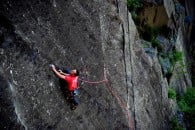

Comments